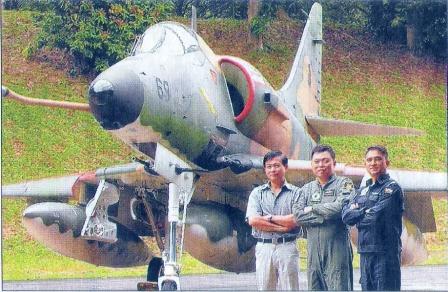
PHOTO: Joyce Fang
FOND MEMORIES: Saying goodbye are (from left) Col Teh, Lt-Col Tay and 2WO Ong. Lt-Col Tay led his team to victory in Super Skyhawks in March's Hotshot combat drill.
Skyhawks bow out on a high note
Exercise to decide RSAF top guns shows planes in good form after 30 years
BY DAVID BOEY
Defence Correspondent
They were less than a month from retirement, but the 31-year-old A-4SU Super Skyhawk warplanes, the stars of the National Day flypasts, showed they were still in top form recently.
Their pilots out-gunned their comrades in far sleeker and newer fighters in March in a major air combat drill codenamed Exercise Hotshot 05, to determine Republic of Singapore Air Force (RSAF) top guns.
It was no mean feat for the men of 142 Squadron, a unit that flies warplanes older than most of its airmen.
Their achievement crowned the three-decade long career here of the American-made warplanes, once the backbone of the RSAF strike force.
The squadron's commanding officer, Lieutenant-Colonel Tay Boon Chong, 37, who had led his men to victory, said of the annual Hotshot exercise: "Every fighter pilot comes to the event prepared to win. I'm very proud my squadron bowed out on a high note."
On March 31, he led 12 twin-seater versions of the Super Skyhawks for their final flight over Singapore.
His had the honour of being the last plane to land that day and of carrying a special passenger — the Chief of Air Force, Major-General Lim Kim Choon.
In a gesture of symbolising that the old warhorses were officially retired, Lt-Col Tay handed the planes over to Brigadier-General Richard Lim, commander of Tengah Air Base, his squadron's home base.
By then, the RSAF's Skyhawk fleet had clocked a whooping 300,000 or so flying hours in total.
While they still had get up and go, they lacked the speed and manoeuvrability of their more advanced stablemates, the F-16s and F-5s.
The one-time US Navy attack jets joined the fledgling RSAF in 1974, destined to be used for ground attack roles.
They were already about 20 years old then and had spent several years stored at an American airbase in Arizona, where the bone-dry air helped preserve them.
Singapore ordered 50, most of which were reconditioned as A-4s by Lockheed Aircraft Services. It was the first of three upgrades they underwent.
They made their debut in a big way — the 1976 National Day celebrations, when the country showed off its air power with a flypast of combat aircraft.
Twenty-seven Skyhawks took part in that jubilant occasion with 27 Hawker Hunter fighters. Six Skyhawks and Hunters accompanied the two groups as spares.
The gathering of 60 still stands as the biggest flypast put on by the RSAF.
The air force had installed a pair of 30mm Aden cannons — a decision that proved to be ill-considered.
Colonel (Volunteer) Teh Wan Joo, 52, a volunteer instructor at the RSAF Flight Simulator Centre, who flew the planes as a young lieutenant, recalled: "The guns had a big punch, and a number of things came off in the cockpit each time they were set off."
Panels on the plane's nose were also tore open. So in the 1980s, the RSAF substituted the guns with smaller ones.
|
PHOTO: Joyce Fang |
|
FOND MEMORIES: Saying goodbye are (from left) Col Teh, Lt-Col Tay and 2WO Ong. Lt-Col Tay led his team to victory in Super Skyhawks in March's Hotshot combat drill. |
While the secondhand warplanes may have been much cheaper than buying new aircraft, keeping them flying was not easy. One particular problem was the engine, as the company that made it had closed.
Col Teh recalled: "These 1950s engines weren't very reliable."
They caused what has been called the Skyhawk Crisis. From July to October 1985, the RSAF lost four planes. The pilot of one plane died.
However, with frequent maintanence, the old engines served till 1993.
In the meantime, plans to replace them were put into high gear.
Two engines were considered, but neither had been put in a Skyhawk before and no one knew how the plane would perform with one of these transplants.
It looked workable, however, and the RSAF decided to try te engine used in the United States Navy F/A-18 Hornet fighter. It was a winner.
When a prototype made its first flight with the new engine on Sept 19, 1986, it outran the F-5F chase planes sent to monitor its performance.
The more powerful engine allowed the aircraft to climb faster, accelerate more rapidly and carry more weapons than the A-4S. It also shortened the Skyhawk's take-off by 30 per cent.
Second Warrant Officer Alywin Ong, 44, a flight line warrant, said: "We were so impressed."
The new engines also needed 25 per cent less time to upkeep.
|
PHOTO: Wings on High |
The new-engine aircraft were a hit — and not just with the pilots and maintenance men. In the hands of aerobatics display team, the Black Knights, they thrilled spectators at the National Day and Asian Aerospace shows.
In the late 1980s, an upgrade in the Skyhawk's electronics improved its navigation and weapons delivery. These were dubbed Super Skyhawks and widely regarded as the most capable of the various versions.
To further improve their edge in air combat, the squadrons experimented with painting a false cockpit on the bottom of one plane, to give the impression it was flying upside down.
The time 2WO Ong did it for real, in 1995, still stands out in his memory. It was in Australia.
"The pilot said over the intercom 'Look behind you', so I turned my head to see what was up. That's when he pulled the aircraft into a loop and there I was, upside down, looking at several Skyhawks that were following us."
He said nostalgically: "When I was introduced to the A-4 in 1979, I was just 17. It's been a good 25 years."
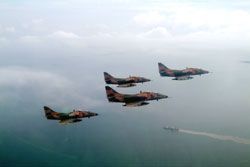 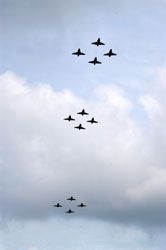 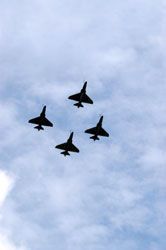 PHOTOS: MINDEF |
|
Three photos showing the final flight of the Super Skyhawk over Singapore. |
|
|
 PHOTO: Pioneer magazine |
1973: Singapore buys 50 former US Navy A-4Bs and TA-4Bs stored at Davis-Monthan Air Force Base in the Arizona desert. Lockheed Aircraft Services rebuilds these as A-4S Skyhawks.
July 14, 1973: A-4S Skyhawk, unique to Singapore, makes its first flight in Ontario, California.
1974: 142 Gryphon Squadron, first A-4S unit, formed at Changi Air Base.
1975: 143 Phoenix Squadron, second A-4S unit, formed at Changi Air Base.
1980: Singapore orders another 70 A-4C airframes stored in Arizona and ships them to Singapore. Singapore Aircraft Industries (SAI) rebuilds planes as A-4S-1.
1984: Ministry of Defence plans Skyhawk engine upgrade.
1984: 145 Hornet Squadron, third Skyhawk unit, formed at Tengah Air Base.
Sept 19, 1986: New Skyhawk variant, the A-4U, makes its first flight using General Electric F404 turbofan engine.
1987: Mindef upgrades A-4U again, this time with new avionics, or aircraft electronics.
1989: New-engine Skyhawks enter service with 143 Squadron. 142 Squadron soon follows.
Aug 9, 1990: 142 Squadron and 145 Squadron form the number "25" at National Day Parade with a formation of 25 A-4U Skyhawks.
1997: 143 Squadron retires its Super Skyhawks.
1998: Ten A-4SU Super Skyhawk sent to RSAF training squadrons in France by cargo ship. Another eight Skyhawks shipped in March 1999.
2003: 145 Squadron retires its Super Skyhawks.
March 31, 2005: 142 Squadron's Siper Skyhawks retired. Twelve Super Skyhawks make last flight over Singapore. Training squadron in France will continue flying Super Skyhawks for another two to three years.
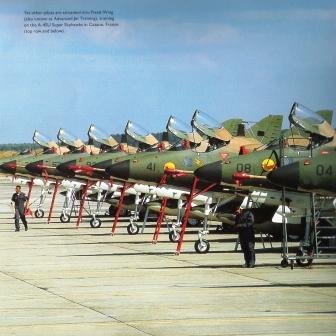 PHOTO: Wings on High |
|
Pilots who show potential are streamed into Fixed-Wing (also known as Advanced Jet Training) on the A-4SU Super Skyhawks in Cazaux, France |
Reproduced from The Straits Times (16/5/2005)
Some photos courtesy of Wings on High, 35 Years of the Republic of Singapore Air Force
(ISBN 981-04-9395-9)